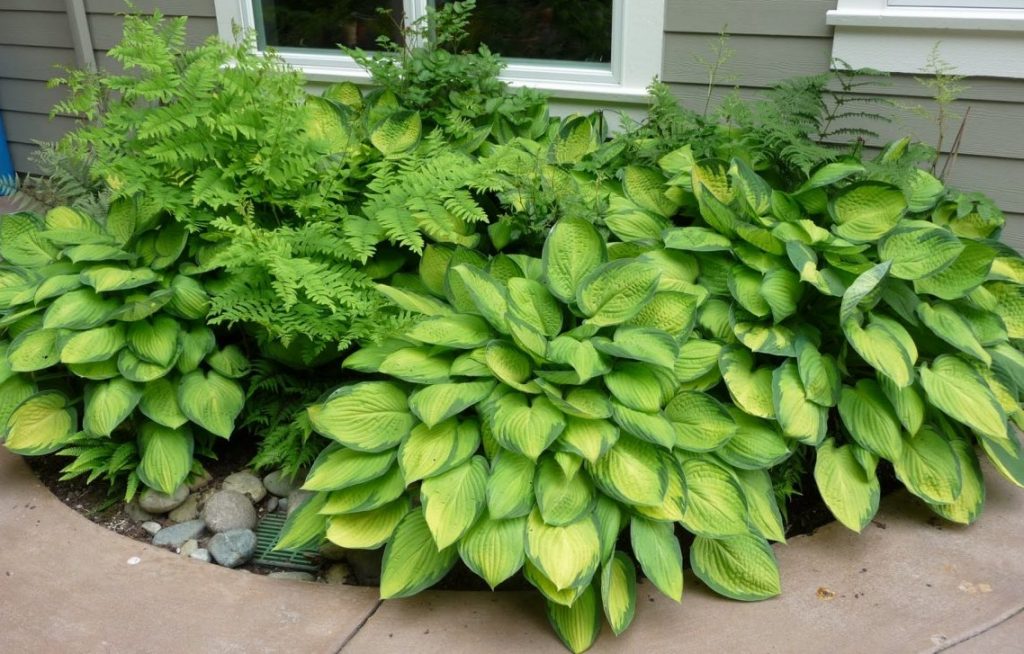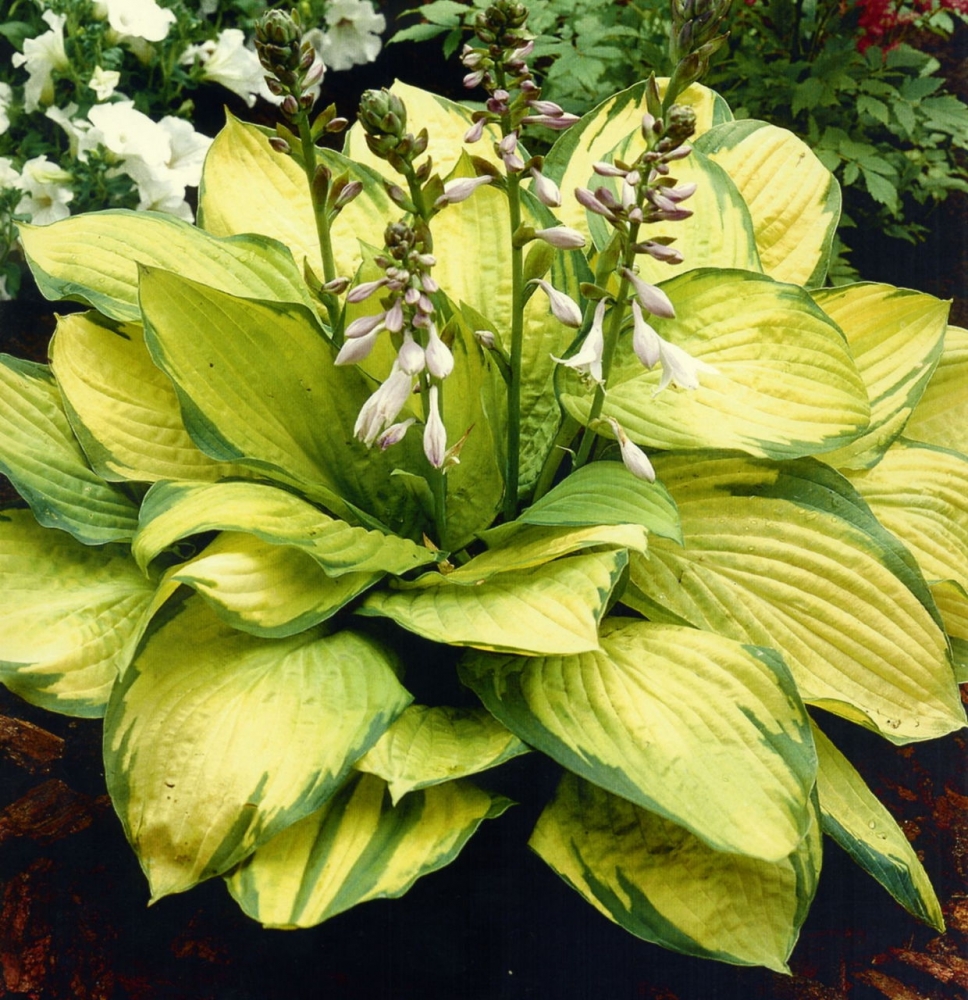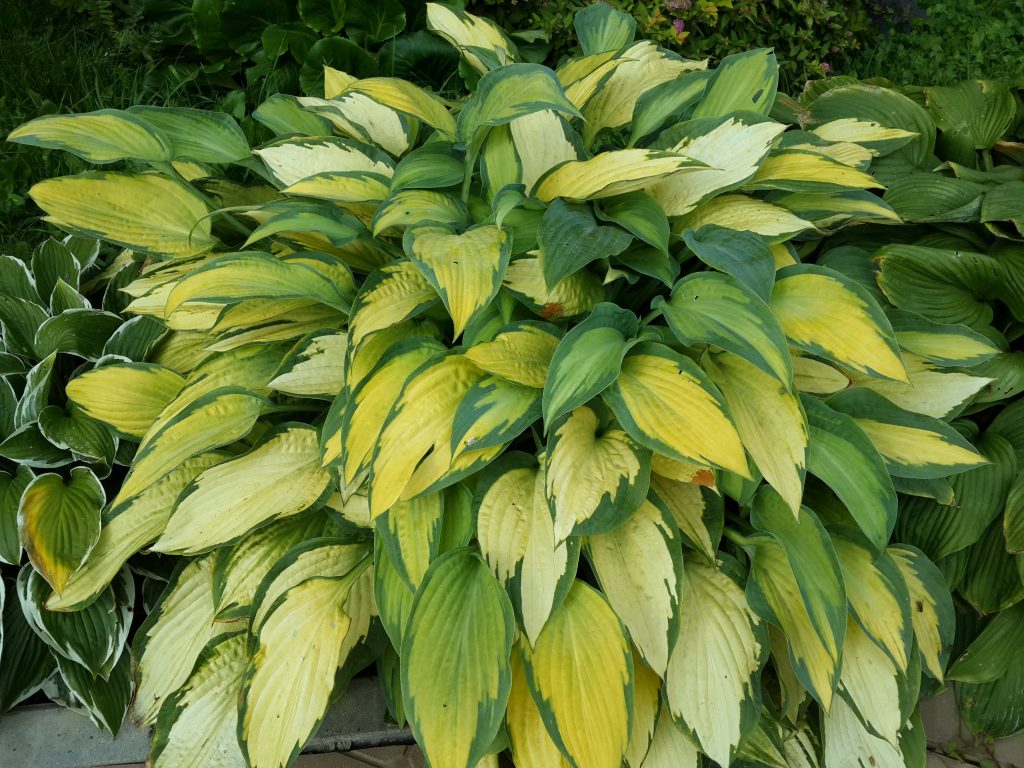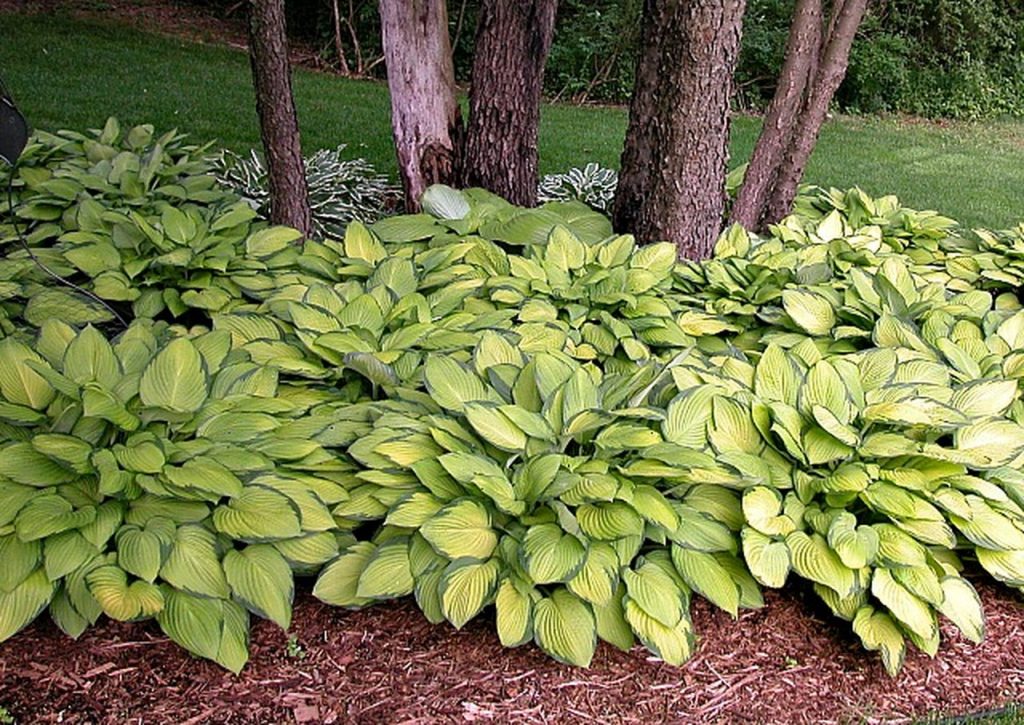Hosta Gold Standard - variety description
Hosta Gold Standard is a classic variety, known since 1976. It is a sport from the Fortune variety (originated by P. Banyai). The yellow-golden color of the shrub fully justifies the name "Gold Standard". Decorative and easy to grow, this feature is extremely popular with gardeners.

Hosta gold standard description
External characteristics
Feature (host) Gold Standard belongs to the Asparagus family. It is a medium-large (according to some sources - large) variety with a fast growth rate. Consider the description of the plant.
Reaches 50-60 cm in height, 120-160 cm in width. The bush is neat, domed. In one place it can grow up to 10 years.
The shape of the leaves is heart-shaped, length - 20 cm, width -12-14 cm. In spring, their color corresponds to the shade of chartreuse with a dark border around the edges. In summer, the middle turns golden, and the edges turn light green. In autumn, the center becomes almost creamy and the rim is yellow.
Flowering occurs in July and August. The flower stalks grow well above the bush and show small bell-shaped flowers of a pale lavender color. There is no pronounced aroma.
Landing features
Usually funkii love shade, but for a fuller manifestation of decorative qualities, the Gold Standard needs sunlight.
In perfect shade, the leaves remain light green, without acquiring a bright golden color.
In the sun, burns are possible, so a light openwork partial shade will be the best place for this hosta.
The soil should be loose, neutral, moderately moist. If there is an accumulation of moisture on the site or groundwater is located too close, you need to make the embankment higher and put good drainage. The distance to the nearest neighbors is at least 50 cm.
Technology:
- They dig a hole 50-60 cm deep and lay drainage (broken brick, crushed stone or small pebbles).
- Garden soil is mixed with compost and peat, complex mineral fertilizers are added.
- The hole is filled with soil mixture by a third, filled with a bucket of water and allowed to absorb moisture.
- The plant is transferred from the container together with a lump, watered, covered with a substrate and tamped.
- From above, the soil around the funkii is mulched with peat chips, needles or pieces of bark.
Care
The Gold Standard function is completely unpretentious and requires very simple maintenance. In hot weather and periods without rain, it should be watered regularly. Top dressing is needed twice a year and pruning once.

Hosta gold standard photo
Watering
Pour the funkia at the root so that moisture does not get on the leaves. An adult plant needs 2-3 buckets of water so that the earth is soaked by 40-50 cm. In the absence of precipitation, irrigation is carried out twice a week.
Top dressing
You can feed the plant with organic fertilizers (compost, rotted manure, peat) or mineral complexes. In the first case, mulching is carried out with dry organic matter (in spring and autumn).In the second, the granules are laid out when loosening or dissolved in water and added after watering.
Loosening and mulching
The root system of the funkia is located close to the surface, so the soil needs to be loosened shallowly (3-5 cm). Mulching is the best option: it will reduce moisture evaporation, keep the roots from overheating and provide a reserve of nutrients. In addition, the procedure will greatly facilitate care and will create the prevention of diseases and pests.
Pruning and preparing for winter
At the end of flowering, dried flower stalks are cut off on the funky, and after the leaves turn yellow, the entire ground part. Hosta Gold Standard is very frost-resistant, but it is better to cover it with a thick layer of mulch for the winter. Young specimens are insulated with pine spruce branches, and covered with dry foliage on top.
Reproduction
The most affordable breeding method is cuttings. It is best held in April or September (however, it is quite possible at other times during the summer).

Host royal standard
A rosette shoot "with a heel" is cut from the bush and the cut is sprinkled with a rooting stimulator. The stalk is deepened into damp earth in a semi-shaded place and covered with a cut plastic bottle. As necessary, the soil is moistened, and the cover is raised for ventilation.
A few years after planting, the hosta can be propagated by dividing the bush. In order not to slow down its growth, it is advisable to do it for 5-6 years.
The bush is dug up and carefully divided into 2-3 parts, leaving an equal number of buds and roots on each. Delenki are planted in the usual way in an openwork shade, watering as needed.
Diseases and pests
| Problem | Symptoms | Prophylaxis | Wrestling |
| Slugs and snails | Slime tracks, eaten holes in the leaves. | Water the funkia in the morning, not in the evening; Sprinkle the soil with ash, tobacco, broken shells, sharp stones. | Collect pests and set traps (beer, plank or plywood). Use drugs based on methylaldehyde. |
| Rot | Brown leaves, thinning of the stems, wilting of the plant, stunted growth. | Moderate watering, laying drainage when planting, disinfection of tools and soil. | Remove infected leaves and shoots, spray the host with fungicides (Trichodermin, Oxyhom, Topaz). Transplant the healthy part of the plant to a new location. If the treatment does not help, the bush must be completely burned. |
| Virus X (only affects hosts) | The leaves wither and deform, a "mosaic" of light spots appears. The bush does not grow, does not bloom and soon dies. | Disinfection of garden tools. Careful examination of the seedlings when buying: they should not have extraneous spots and mosaic patterns. | Unfortunately, the disease cannot be cured. The plant must be burned. |
Use in garden landscape
The cute Gold Standard bush is consistently popular in landscaping. He successfully diversifies monotonous compositions and smooths out the riot of colors in flower beds. It is often planted as a groundcover, living curbs, and next to shrubs or trees that lack lush foliage at the base.

Hosta golden standard
Diffused light and openwork shading will provide the host with the proximity of ferns, firs, thujas, junipers - while such combinations look very organic.
Gold Standard looks great with vertically growing phlox and delphinium. It goes well with roses, lilies, lavender, peonies, astilbe.
Variety reviews
The Gold Standard function is one of the most common and well-proven varieties. The choice of beginner and experienced flower growers often stops at it (as well as on the sports of this function: Royal Golden Jubilee, Flip Flop, Moonlight, Work of Art, etc.). Judging by the reviews, the host is unpretentious, frost-resistant, not prone to diseases.
Most gardeners plant it in diffused sunlight, rather than in the shade, so that the leaves are brighter.Some people value funkia more for its lush bush and beautiful leaves, not counting the decorative flowers. They break off the flower stalks to prevent flowering and not "spoil" the neat domed shape of the bush.

